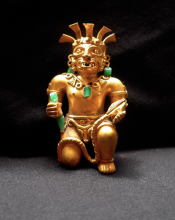Submitted by ARASAllison on
 The first time I encountered a wide range of pre-Columbian art was during a trip to Machu Picchu, Peru. What I saw at that moment was mind-blowing.
The first time I encountered a wide range of pre-Columbian art was during a trip to Machu Picchu, Peru. What I saw at that moment was mind-blowing.
I. Cuzco: A City Built on Top of Another City
When you land in Cuzco, your first impression is that of a charming Spanish colonial city. You quickly find the main square and the Cathedral, recognizing the typical structure of cities built by the Spanish conquerors. However, very soon, the presence of indigenous culture begins to capture your attention.
The contrast between the European traits and the distinctive Peruvian traits is striking. Gradually, you notice differences not only in appearance but also in attitude and demeanor. Alongside the confident manner of most foreigners, you see the cautious and shy behavior of the locals. Their expressions to my mind reveal a kind of sadness or loneliness.
As you walk through the city, you discover Cuzco's history: the main buildings, symbols of the Spanish Crown's power, were constructed over the ruins of ancient Inca structures. The ruins reveal a traumatic history of violence and destruction brought by the Spanish conquerors. This history explains the sad expressions on the faces of the descendants of the conquered Incas. It is the same expression we recognize in our patients and others who have been traumatized. Despite the years that have passed, they still bear the stigma of the clash between the Europeans and their ancestors.
From a psychological perspective, our perception of reality is deeply influenced by our personal history. The Ego complex can eclipse our awareness of the Self, and our Objective Psyche can be obscured by our prejudices and rational frameworks built through previous experiences. Similarly, our patriarchal and European education has limited our ability to experience other dimensions of reality.